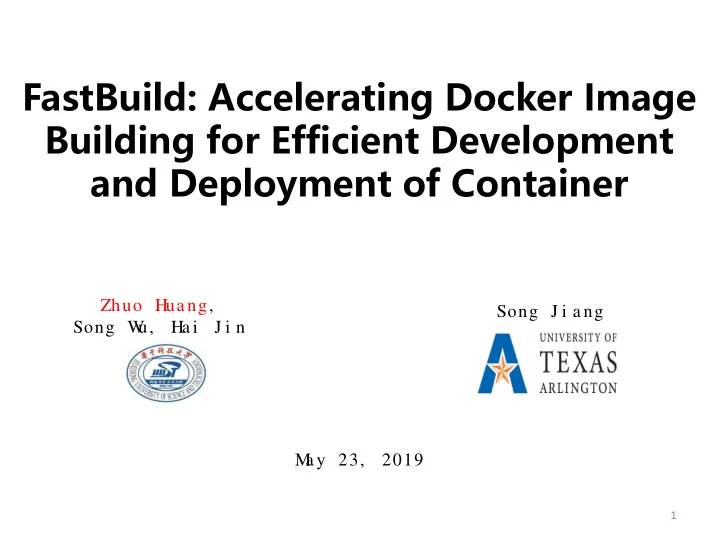

FastBuild: Accelerating Docker Image Building for Efficient Development and Deployment of Container Zhuo Hua ng, Song J i a ng Song W u, Ha i J i n M a y 23, 2019 1
Outline Background and Motivation Design of FastBuild Evaluations Summary 2
Container is Popular amazon 3
Starting a Container By design: containers are lightweight can be started as fast as a process In practice: container startup is much slower 25 seconds startup time “task startup latency (the time from job submission to a task running) is an area that has received and continues to receive significant attention. It is highly variable, with the median typically about 25 s. Package installation takes about 80% of the total” — — Large-scale cluster management at Google with Borg (EuroSys'15) 4
Container Image An application is packaged as a container image that includes: • application binary • shared libraries Linux distribution • ④ Read-Write Layer Container ③ Read-Only Layer ② Image Read-Only Layer ② Read-Only Layer ① 5
Image Building Containers are becoming heavyweight: File File File Serve File Server Server r Server Remote Layer Layer internet Layer run Image build Container Starting a container requires the image to be available. 6
Analysis Objective: Accelerate Docker image building Method: Build 2746 container images base images are downloaded more than 100,000 times divided into 137 groups according to different repositories Build DevOps Update Run 7
Our Findings 70% of the building time is spent on the remote file access 80% of downloaded data are duplicated 30% overlap of input data in different base images 8
Outline Background and Motivation Design of FastBuild Evaluations Summary 9
Design Challenge Obtain the requests for inputs without changing the image. Docker Daemon Dockerfile Container Remote RUN apt-get install gcc apt-get install gcc COPY FROM ... Local Images 10
Design of FastBuild Interception of requests for input files ①: Resolve the container to the main process id; ②: Find out the network namespace by reading the /proc; ③: Fork a child process to attach the namespace; ④⑤: Check the file timestamp; ⑥⑦: Search the local file cache. 11
Design FastBuild Instruction Overlapping overlap instruction execution and layer commitment build multiple layers of an image in one container instance take a snapshot after executing each line instructions Quickly Obtaining Base Image leverage the previous optimization to locally build base images. 12
Outline Background and Motivation Design of FastBuild Evaluations Summary 13
Evaluations Experiment environment: 2.3 GHz Xeon CPUs(E5-2620) 64GB RAM Intel Gigabit CT PCIE Network Adapter West Digital WD60PURX hard disk China Education and Research Network FastBuild prototype: 300 LoC for redirecting Dockerfile instruction 500 LoC for optimizing container runtime 1800 LoC for cache lookup 14
Evaluations FastBuild is about 4X faster than stock Docker for different image groups. FastBuild is 3.2X faster than stock Docker after execution of 6 Dockerfiles. FastBuild reduces 71.9% data downloaded. FastBuild can be 10.6X faster on the 5Mbps network. 10.6X 71.9% 15
Outline Background and Motivation Design of FastBuild Evaluations Summary 16
Summary We extensively study how frequently input files are reaccessed in the building of Docker images and reveal opportunity of maintaining a local file cache for accelerating the process. We propose and design FastBuild, a file caching function seamlessly integrated in Docker to transparently intercept requests for input files to minimize remote file access. We prototype FastBuild in Docker 17.12 and extensively evaluate its impact on speed of Docker image building. 17
Thanks for your attention! Any questions? huangzhuo@hust.edu.cn 18
Recommend
More recommend